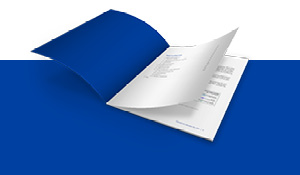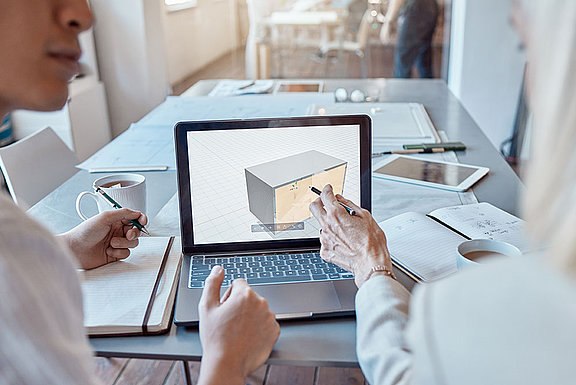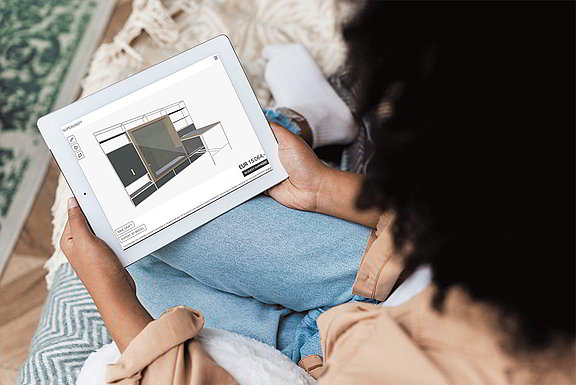Discover the diversity of product visualization - What are the types?
Author: Klaus Pilsl
Today we're talking about a topic that is indispensable for online sales: product visualization. When we stand in the store, we can take the product in our hands, smell it, examine it, and get an accurate picture of it. But what does that look like in the online store? We can't touch the product, smell it, or look inside - unless we have a particularly good imagination.
But fortunately there are ways to make the product visually tangible. Because the better we can imagine it, the more likely we are to get excited about it. This in turn makes us more willing to buy the product.
What is product visualization?
Product visualization refers to the visual representation of products of all kinds. Visualization can take a variety of forms, from simple drawings and photos to 3D models or even virtual reality experiences.
Another definition of product visualization states that it is a technique used to illustrate products that are otherwise difficult to explain or understand. Users thus gain a comprehensive understanding through product visualization.
What are the advantages of product visualization?
Product visualization offers many advantages. The goal of product visualization is to present a product in such a way that it is appealing and understandable to customers. By being able to present the product in the best possible way, customers feel engaged and involved, which leads to better customer loyalty. Product visualization is often used in advertising or marketing to showcase products and demonstrate their features and benefits. In addition, product visualization is also used for product development to visualize designs or prototypes and to identify potential problems at an early stage before it goes into production.

Configurator checklist
Avoid stumbling blocks.

What are the basic types for product visualization?
But which product visualization technologies are suitable for this? That depends entirely on the product and, above all, on what is important to the customer. Do they want details to be highlighted? Do customers want to see the product in action? Does a certain function need to be explained that is otherwise not immediately obvious to the user?
You can choose from the following types of product visualization:
- 2D
- Video
- 3D
- Extended Reality (XR)
Each of these visualization types has advantages and disadvantages.
2D product visualization
The 2D representation is the simplest form of visualization. It refers to the representation of products on a two-dimensional surface. This can be in the form of drawings, sketches, photos or graphics that show the product from different angles. They are often used in advertising or catalogs to present products and illustrate their functions and features. Because of their simplicity and the fact that 2D imagery may already be available, this is often the least expensive and fastest way to create a product visualization and maintain the content on an ongoing basis. Although 2D visualizations are often less detailed than 3D visualizations, they can still give a clear impression of a product.
Advantages:
- Easy to create
- Widespread expertise in the market to create the graphics
- Short loading times
Disadvantages:
- Rigid representation
- Often more complex than creating 3D graphics
Possible at Combeenation: yes
Creation effort: High
Video
Moving images offer an appealing opportunity to show the product in use, to point out functions and to communicate explanations in a way that is easy for customers to understand. This form requires the least user interaction, as the video is basically linear. However, there are also possibilities to influence the video flow by asking questions and offering answer buttons in the video. 360° videos offer another possibility to interact with the video. Here, the content also runs in a linear fashion, but the user can change the viewing direction of the video continuously.
However, it is important to know that video can usually only be used for explanatory purposes in product visualization. Active configuration of the product to be shown in the video is usually too costly in view of the alternatives shown here. Therefore, video is mostly limited to explanatory tasks.
Advantages:
- Guided, easy to consume presentation
- Sharing of the audio channel for further explanation of the product
Disadvantages:
- Video content is not configurable
- With few exceptions, the presentation path is fixed
Possible at Combeenation: yes
Creation effort: Medium
3D product visualization
3D product visualization refers to the representation of data or information in three-dimensional form that creates a spatial image. Unlike traditional two-dimensional representation, 3D product visualization allows realistic representation of objects and scenes from different perspectives. 3D visualization is fascinating and impressive. It makes it possible to involve and inspire customers in the development process from the very beginning. Due to the numerous design possibilities of 3D visualization, creative and individual product presentations can be created - even before the product has ever been manufactured. Have you read our blog article, "3D Visualization vs. Product Photography?" If you need 3D models and help creating them, feel free to contact us.
Advantages:
- High product experience (interactivity and configuration feedback)
- Very good integration into interactive configuration
- Interactive camera guidance to show details
Disadvantages:
- Few Expert:in available on the market for creation
- Longer loading times
Possible with Combeenation: Yes
Product examples: Sports equipment, houses, machinery, consumer goods, ...
Creation effort: Medium
Extended Reality (XR)
XR is the umbrella term for Mixed Reality (MR), Augmented Reality (AR) and Virtual Reality (VR). These technologies absolutely require 3D data. They thus build on and extend the 3D product visualization described above. In VR, the product is placed in a virtual space using a closed headset. This requires a dedicated VR headset. With AR, a smartphone or tablet is usually used to place the product in the moving image of the real environment via the built-in camera. In the case of MR, open glasses are used through which the user can see the environment and at the same time the 3D product is superimposed.
Advantages:
- All the advantages of 3D, plus the product can be viewed in its own environment
Disadvantages:
- Not all end devices support it (e.g. desktop)
Special glasses are required for VR (low penetration)
Possible with Combeenation: Yes
Product examples: Furniture, tableware, construction elements
Creation effort: low (3D required)

What effort is required per product visualization?
The effort required for a product visualization depends on various factors, such as the scope and complexity of the project, the type of visualization, the required output quality and the desired result. It is important to plan the effort in advance and allocate resources accordingly to ensure that the result meets the requirements. The least effort is 2D visualization followed by 3D visualization. Significantly more costly are videos followed by virtual reality. But here, too, caution is advised, because simple and straightforward videos are often implemented more quickly than elaborate 3D data.
What are the costs per product visualization?
Again, we can't give a flat price, but we can give an approximate indication. 2D visualizations are usually cheaper than 3D visualizations, video visualizations or XR visualizations. Nevertheless, one must always keep in mind the scope of the project and the desired output quality. A higher output quality often requires more work and higher costs, as it requires a higher level of detail. Our tip: do not decide on the basis of price, it is important that the result fits and that you convince your customers.
Excursus: Configurator and types of product visualization
An important component of the configurator is the product visualization. In order for product visualizations to work in a configurator, it must of course be possible to adapt them dynamically. This means that an engine - such as the Combeenation platform - is required to drive the visualizations accordingly. The configurator platform works in particular with 2D and 3D product visualizations, and can also combine these with each other as desired. This now makes it possible to have the product visualization react to customer requests in real time - whether as a reaction to user input in the configurator, or directly and interactively in the product visualization of the configurator. The product is thus virtually "brought to life", the users begin to communicate with the product, to get to know it and they begin to build up a bond with the product.

Conclusion
In summary, effective visualization is a decisive factor in convincing potential customers of the merits of a product. However, it is important to find a balance between the abundance of information and click depth, and the clarity of the presentation.
It can quickly happen that customers are presented with too many options that overwhelm them and deter them from making a purchase. Therefore, we should concentrate on the essential information and not overload customers with too many details.
A helpful guideline for choosing the level of detail is the product's shopping cart value. In the case of lower-priced products, simple visualizations should be used to guide customers quickly to their destination, while more detailed visualizations are appropriate for higher-priced products in order to engage customers emotionally.
All in all, we should value the time users give us and use it sparingly to effectively inspire them with our products. With balanced and targeted visualization, we can successfully attract customers and increase our business success.
FAQ
What is product visualization?
Product visualization refers to the creation of digital models, images or animations to represent products or designs in an appealing way. Visualization can be used for various purposes, such as marketing, presentations or product development.
What are the different types of product visualization?
There are different types of product visualization. The most common forms are 2D visualization using images and drawings, and 3D product visualizations that provide spatial representation. Video visualizations provide motion and action, while XR visualizations such as augmented and virtual reality provide interactive and immersive representations to showcase products in a unique way.
Where can you use product visualization?
Product visualization can be used in many areas, such as product development, marketing, presentation of products or concepts, architecture and construction, medicine, mechanical engineering and many other industries. There are almost no limits to the field of application - both in B2B and B2C. Product visualization is particularly predestined for configurators. Do you already know our references?
How time-consuming is product visualization?
Product visualization requires different amounts of effort, depending on factors such as project scope, complexity, type and quality of the desired output. 2D visualization is the least costly, followed by 3D visualization, videos and virtual reality. However, even with simpler techniques, resources should be planned carefully, as elaborate 3D data can sometimes take longer than simple videos.

Configurator checklist
Avoid stumbling blocks.

